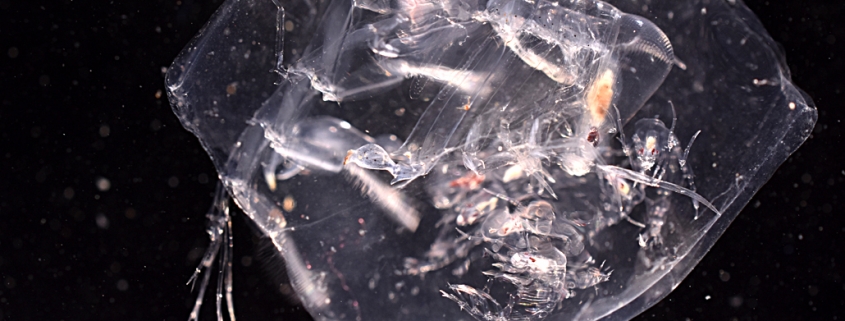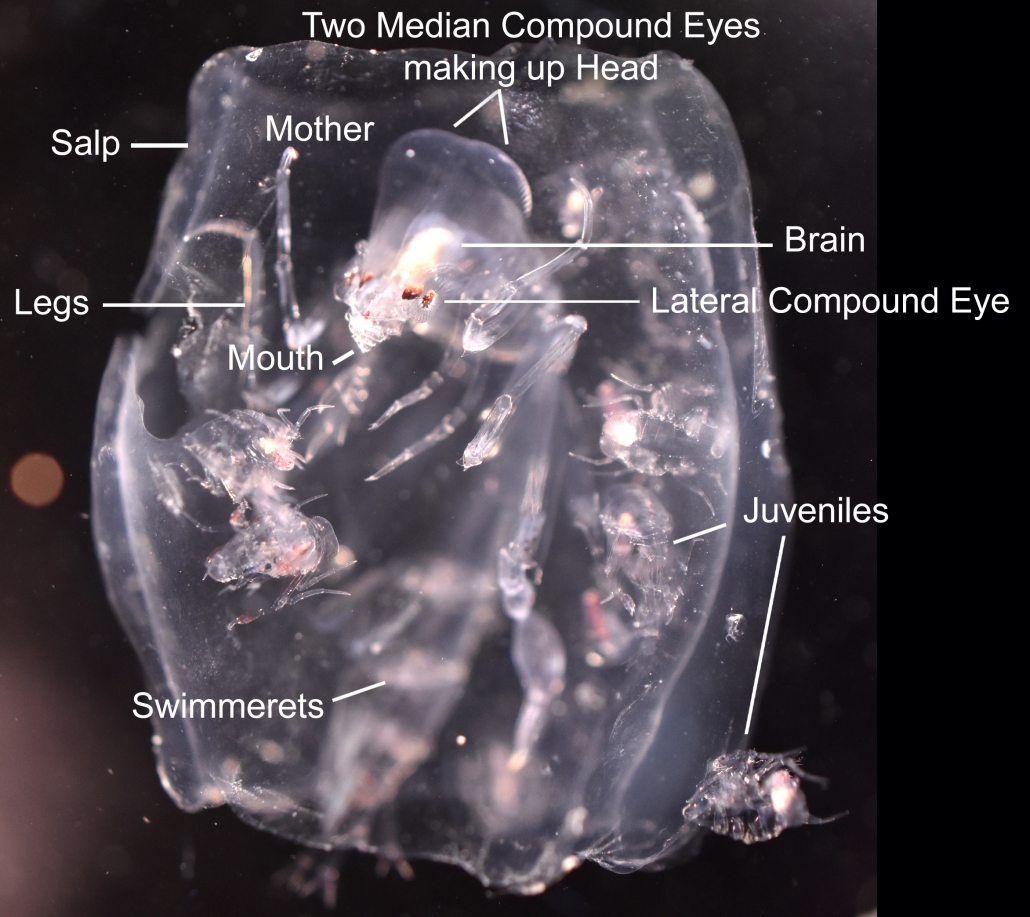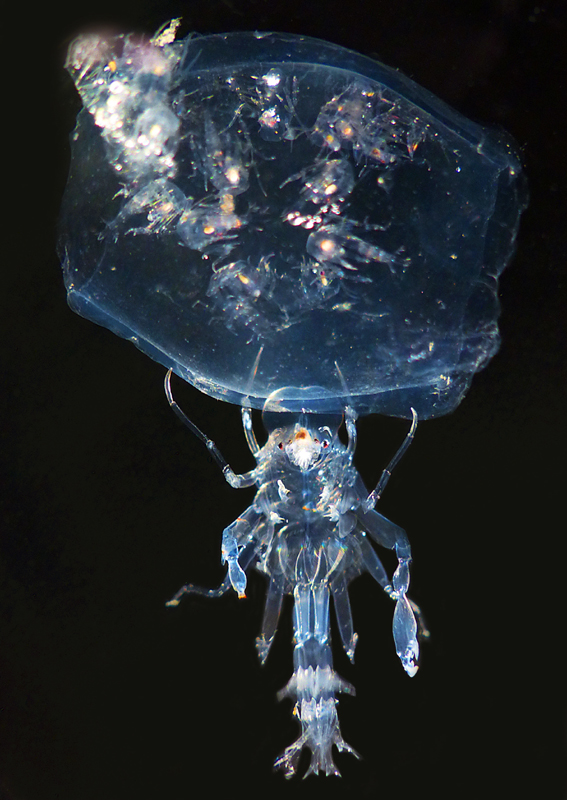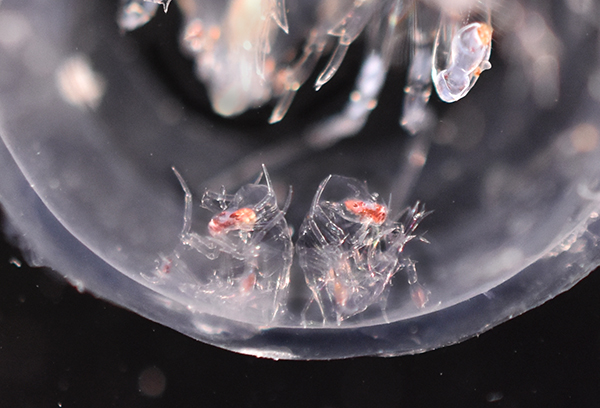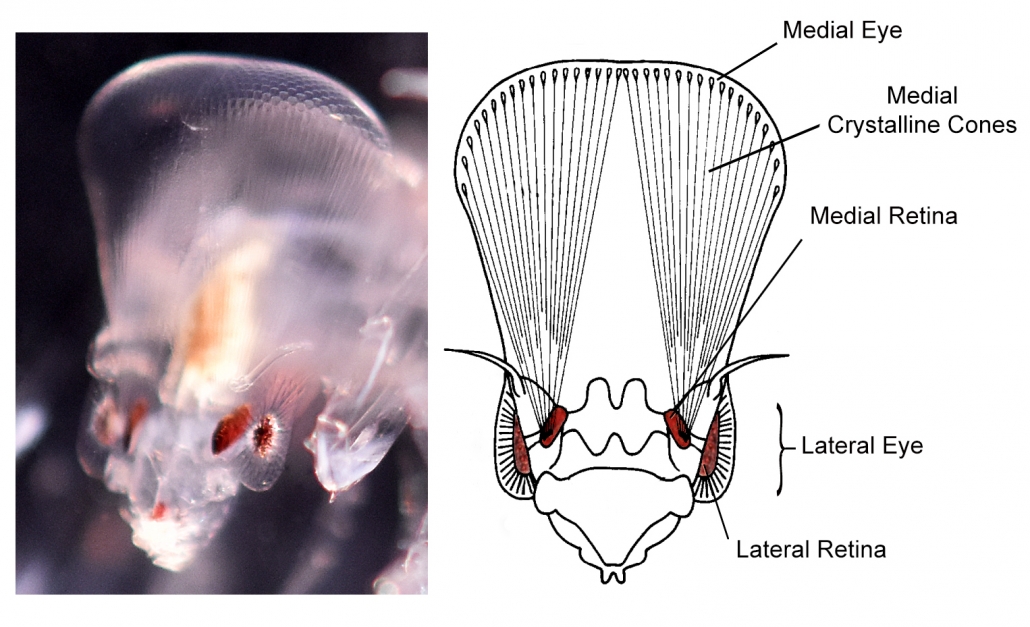Phronima Sedentaria
Scientific Name: Phronima sedentaria
Author: Eduarda Ferro Braga Laurindo Correia
Size Range: These are tiny creatures with sizes ranging from 1.2-4.2 cm (~0.5 to 1.7 inches).
Life Expectancy: They live around one year.
Identifying Features: Phronima sedentaria can be distiguished by its very large head which is composed of two very large transparent compound eyes. It also has two lateral compound eyes and 4 distinct red retinae. The internal anatomy of these creatures is reasonably similar to that of other amphipods, but there are some key characteristics that differentiate them. As an example, their foregut is reduced and surrounded by a midgut chamber. Their brain is circumesophageal with four pairs of major nerves, that lead to their 4 compound eyes and to their ventral nerve cord and antennules. This organism has numerous specialized legs including two large claws, as well as a tail with 3 pairs of swimmerets (pleopods) it uses for swimming. They also have pigmented-cells called chromatophores that are responsible for camouflage; these cells contract to give the organism a transparent appearance so it will be unseen or mistaken as harmless plankton by the prey.
Mating Behaviour: Males use their antennae to find potential mating partners in response to the release of pheromones by the females. The male will then ride or hold onto the female until she is ready to molt, the male will then push the sperm into the marsupium and release the female when it is complete. After a couple of hours, the female will release her eggs into the marsupium for fertilization.
Habitat: They are usually found in temperate and tropical waters around the world and can live anywhere between the surface and deep water.
Food: Their feeding behaviours depend on the consistency of the food being eaten. The specialized legs called pereiopods are used during feeding to pick and pull prey with soft bodies toward their mouths, where the mouthparts are responsible for removing smaller pieces and directing them to the esophagus. When the tissue of the prey is tough other pereiopods work to keep it across the mouth cone area while the mandible breaks it down into smaller pieces. If the tissue is fluid-like, the contents will be sucked into the foregut with the help of the muscles of the esophagus and gut. One example of food they might ingest is zooplankton.
Predators: Fish are some of the most prominent predators.
The photo above shows the adult female that ventured outside of the salp containing her juvenile offspring within.
Life Cycle: Phronima sedentaria make their homes in hallowed salps. They attack their victims by slicing them open with their claws, eating the soft tissue of the prey and then using the barrel-like leftovers as a gelatinous home. Females will lay their eggs in this barrel, which also provides protection from predators and space for food storage. These eggs will hatch inside of the barrel, and it will, later on, serve as food for the young amphipods. These young amphipods can be seen swimming around the barrel. At times both the adult and juveniles in our lab could be seen leaving the barrel and re-entering it.
Two juveniles inside the salp with their mother’s head above.
The visual system of Phronima sedentaria has been described as extraordinary and has often been studied. The two median compound eyes are unusual in their size with crystalline cones reaching up to 5mm in length. The structure is thought to give Phronima resolution under very low light levels while also being transparent, a benefit when avoiding detection by predators.
The illustration on the right is adapted from Ball, E. E. 1977. Fine structure of the compound eyes of the midwater amphipod Phronima in relation to behavior and habitat. Tissue & Cell 1977 9 (3) 521-536
Video Production: Eduarda Ferro Braga Laurindo Correia
Photos and Video: Misha Young and David Young
Special thanks for Misha for finding the specimen off the shores of Victoria.
References:
Amphipod: Salp Invader. (2018, May 18). Retrieved January 25, 2021, from https://ocean.si.edu/ocean-life/invertebrates/amphipod-salp-invader
Ball, E. E. (1977). Fine structure of the compound eyes of the midwater amphipod Phronima in relation to behavior and habitat. Tissue and Cell, 9(3), 521-536. doi:10.1016/0040-8166(77)90010-6
Diebel, Carol. (1988, January 1). Observations on the Anatomy and Behavior of Phronima Sedentaria (Forskal) (Amphipoda: Hyperiidea). Journal of Crustacean Biology, 8(1). Retrieved January 25, 2021, from https://academic.oup.com/jcb/article-abstract/8/1/79/2327686?redirectedFrom=fulltext
Phronima sedentaria. (n.d.). Retrieved January 25, 2021, from http://sio-legacy.ucsd.edu/zooplanktonguide/species/phronima-sedentaria
Phronima sedentaria. (n.d.). Retrieved January 25, 2021, from https://www.sealifebase.ca/summary/Phronima-sedentaria.html
Van Couwelaar, M. (n.d.). Zooplankton and Micronekton of the North Sea. Retrieved January 25, 2021, from http://species-identification.org/species.php?species_group=zmns&menuentry=soorten&id=370&tab=beschrijving
Young, L. (n.d.). A Plankton Species Straight Out Of A Horror Movie. Retrieved January 25, 2021, from https://www.sciencefriday.com/articles/monster-in-a-barrel-and-other-haunting-ocean-drifters/


